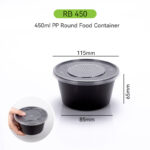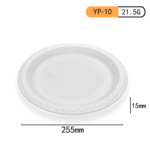Quick Summary
By 2025–2026, the global biodegradable tableware industry is undergoing a seismic shift. With regulatory frameworks like EN13432, ASTM D6400/BPI, ISO 17088, and national bans on single-use plastics, compliance has become the single most important factor in market access. Governments in the EU, US, Canada, and Asia-Pacific are enforcing Extended Producer Responsibility (EPR), compostable labeling laws, and digital traceability systems. Companies that adopt certified, PFAS-free materials such as bagasse, PLA, and PHA—and combine them with AI-driven compliance management—are best positioned to thrive in this new environment.
1. Introduction: The Regulatory Turning Point
The food packaging industry has always evolved with consumer habits and technological innovation, but 2025 marks a new regulatory era. What began with scattered bans on plastic straws and foam clamshells has now grown into a global compliance movement. Governments are no longer leaving sustainability to corporate goodwill—they are mandating certifications, restricting false claims, and penalizing non-compliance.
For exporters, manufacturers, and retailers, these changes are not just bureaucratic hurdles. Compliance now determines:
-
Market entry and customs clearance
-
Brand reputation and consumer trust
-
Access to corporate procurement and ESG-sensitive buyers
-
Future-proofing against evolving sustainability laws
In short: the winners of 2025–2026 will be companies that combine certified biodegradable materials with data-driven compliance and AI-enabled traceability.
2. The 2025 Compliance Landscape: A Global View
Europe: EN13432 and EPR Enforcement
The European Union remains the strictest market for biodegradable tableware. EN13432 certification—the standard for industrial compostability—is now a mandatory passport for any compostable product. Every plate, bowl, or clamshell must prove that it disintegrates under industrial composting conditions within prescribed timeframes.
Equally important is Extended Producer Responsibility (EPR). Exporters must register in systems like LUCID (Germany) or CITEO (France), reporting packaging materials, tonnage, and recycling/composting performance.
Failure to comply means customs delays, fines, or permanent bans. According to the European Commission, 2024 saw a 40% increase in EPR registrations and a 23% rise in compliance audits.
United States: ASTM D6400, BPI, and Labeling Laws
The US relies on ASTM D6400 as the gold standard for compostable plastics and bagasse tableware. In practice, BPI certification is required for nearly all products marketed as “compostable.”
Several states—including California, Washington, and New York—ban the use of unverified “biodegradable” claims. Labels must feature recognized certification logos.
This crackdown reflects consumer protection concerns: too many “greenwashed” products previously misled buyers. Now, compliance equals credibility.
Canada: Plastics Ban and PFAS-Free Requirement
Canada enforces SOR/2022-138, a sweeping regulation banning many single-use plastics. Alternatives must be certified compostable and free from harmful substances like PFAS, PVC, and polystyrene.
Canadian retailers increasingly demand third-party proof from suppliers. As a result, BPI certifications for Canadian exports increased 28% year-over-year between 2023–2025.
Asia-Pacific: Japan, Singapore, and Malaysia Leading the Way
-
Japan: The Plastic Resource Circulation Act now requires all imported packaging to be registered, traceable, and certified by JSA/SOLAS or equivalent standards.
-
Singapore: Its nationwide EPR and plastic ban means every compostable container must be certified under EN13432 or ISO 17088.
-
Malaysia & Thailand: Both countries demand strict certification; violators face port seizures or blacklisting.
Singapore’s imports of certified eco-packaging rose 34% in Q1 2025, a sign that compliant products like bagasse and PLA are gaining traction.
3. Market Data: Growth and Demand Hotspots
The global biodegradable food packaging market is projected to hit USD $36.4 billion in 2025, growing at a CAGR of 18.7% (2023–2027).
Key Insights:
-
Europe and Asia-Pacific lead in demand due to strict regulations.
-
Bagasse dominates (35% of compostable exports), followed by PLA and PHA.
-
Corporate ESG initiatives and government procurement programs increasingly favor certified suppliers.
Top Export Markets (2025):
-
EU – 520,000 tons (EN13432 + EPR)
-
USA – 290,000 tons (ASTM D6400 + BPI)
-
Canada – 110,000 tons
-
Japan – 105,000 tons
-
Singapore – 60,000 tons
4. The Materials That Matter: Bagasse, PLA, PHA
Bagasse: The Champion
-
Made from sugarcane fiber waste
-
PFAS-free, compostable in both home and industrial systems
-
Strong, grease- and heat-resistant
-
Accounts for over one-third of certified exports
PLA (Polylactic Acid)
-
Plant-derived bioplastic
-
Compostable only in industrial facilities
-
Popular for cold drinks, straws, and salad containers
PHA (Polyhydroxyalkanoates)
-
Next-generation microbial bioplastic
-
Compostable in marine and soil environments
-
Emerging in cutlery, wraps, and flexible packaging
5. Compliance, Certification, and Digital Traceability
2025’s reality: Certificates are the new passport.
Every shipment must include:
-
Valid, accredited certificates (TÜV, BPI, JSA)
-
Online verification links or QR codes
-
SKU-level compliance data
Importers now use blockchain-backed databases to verify authenticity. Non-transparent suppliers face exclusion from tenders and audits.
6. Business Strategies: How Leaders Adapt
Best Practices
-
Dual Certification: Products pre-certified for both EU (EN13432) and US (ASTM D6400).
-
PFAS-Free Materials: Switching to safe bagasse for plates, trays, and clamshells.
-
QR-Linked Traceability: Packaging that links to certificates and environmental data.
-
AI-Optimized Compliance: Automated tools monitor laws, verify certificates, and reduce export risks.
Major exporters like Huhtamaki and Sabert already integrate compliance teams and AI solutions into operations.
7. The Role of AI in Packaging Compliance
AI is emerging as the “silent enabler” of packaging exports.
-
Certificate Verification: Instantly validates against TÜV Austria, BPI, or JSA databases.
-
Regulation Monitoring: Tracks global updates and alerts exporters.
-
Pre-Shipment Risk Scoring: Flags high-risk shipments before customs issues occur.
-
Dynamic Reporting: Generates compliance reports tailored to each buyer or regulator.
-
Integration with Customs: Pre-submits compliance files to speed border clearance.
In short: AI saves time, reduces errors, and secures market access.
8. Opportunities and Risks
Opportunities
-
Premium Pricing: Certified products sell for 15–25% higher margins.
-
Market Access: Only compliant goods qualify for tenders.
-
Brand Differentiation: Transparent, traceable supply chains win contracts.
Risks
-
Border Seizures for non-certified products
-
“Name and Shame” listings of non-compliant exporters
-
Rapid policy changes, requiring constant vigilance
9. Recommendations for Exporters and Brands
-
Certify Everything: Dual-certify (EN13432 + ASTM D6400).
-
Register EPR: Without EPR numbers, customs clearance is impossible.
-
Go Digital: QR codes, blockchain logs, and AI monitoring are now baseline tools.
-
Stay Updated: Monitor EU, US, and APAC policy announcements.
-
Leverage Data: Showcase compliance in proposals and client pitches.
10. FAQ
Q1: What is EN13432 certification?
A: It is the EU’s compostability standard, mandatory for any “compostable” claim.
Q2: Can I sell biodegradable plates in the US without BPI?
A: No. ASTM D6400 and BPI certification are required in most states.
Q3: What is EPR?
A: Extended Producer Responsibility, requiring exporters to register and report packaging waste.
Q4: Which materials are most accepted globally?
A: Bagasse, PLA, and PHA, all with proper certification.
Q5: How does AI help compliance?
A: AI automates certificate validation, monitors regulations, manages documents, and minimizes customs delays.
11. References
-
European Commission: Packaging Waste & EPR
-
BPI Certification Directory
-
Allied Market Research: Biodegradable Packaging Market 2025
-
TÜV Austria – Compostable Certification Guidelines
-
METI Japan – Plastic Resource Circulation Act





